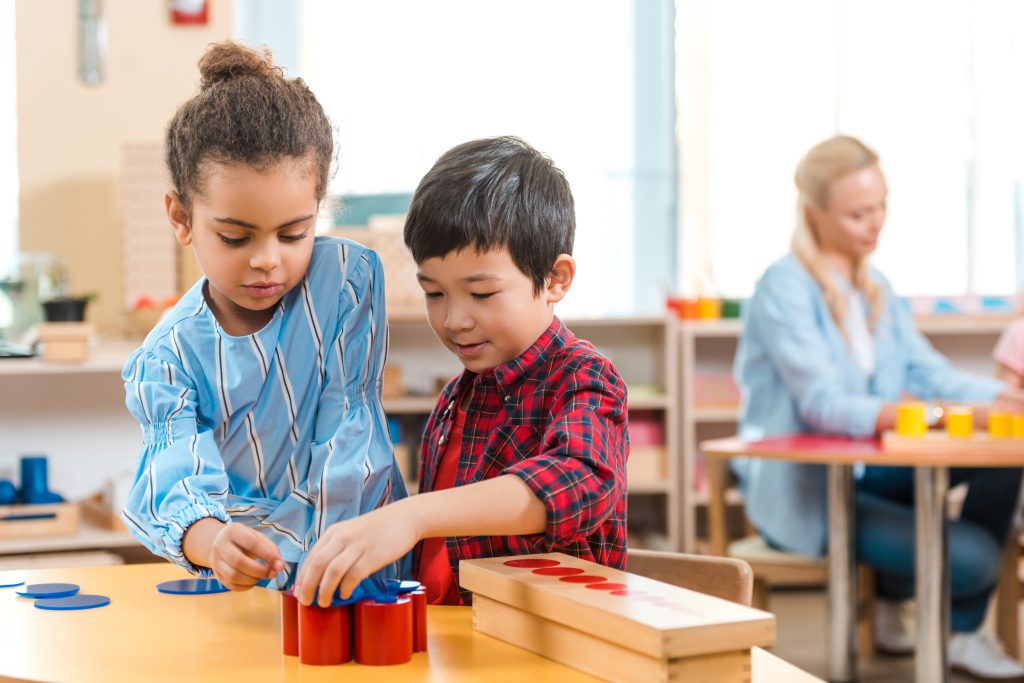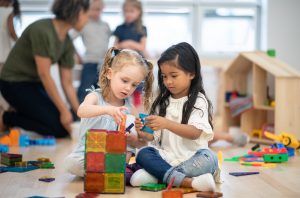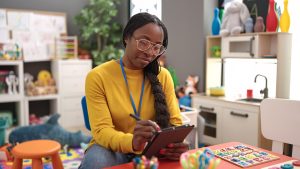- Building teamwork into early math activities develops children’s math and social skills at the same time.
- There are concrete steps that teachers can take to promote peer collaboration during math learning time.
- We offer resources to support early math development and peer collaboration.
Offering children opportunities to exchange ideas and work together to solve problems is powerful for learning. This is especially true when supporting the development of young children’s math skills. Research shows that collaborating with peers during early math activities can support later academic success. [1]
Yet, peer collaboration during early math learning activities is rare. Instead, the most common type of interaction among young children during math learning activities is parallel play. [2,3] This is when children use the same materials and sit near one another, but are engaged in very little actual interaction. Parallel play does not have the same benefits as peer collaboration when children work together and share ideas in ways that build on each other’s knowledge and skills.
With support from teachers, peer collaboration can become business-as-usual when children are engaged in early math learning and other activities. This blog outlines 10 ideas for promoting peer collaboration in early childhood settings. Explore these ideas in-depth and find more tips for putting these ideas into practice in this article.
Encourage Peer Collaboration in Group Activities
1: Know what collaboration looks like.
Peer collaboration is more than just sitting together or taking turns. Collaboration involves children learning from one another by exchanging ideas, information, and materials, and coordinating decisions toward a shared goal.
2: Teach the skills of collaboration.
Model and explain why it’s important to share ideas, plan together, and negotiate disagreements. Use reminders to practice these skills, such as “Huddle up, it’s planning time,” “Talk together about what you want to build,” and “Don’t forget to check your partner’s work.”
3: Create a classroom culture that values collaboration.
Help students grow mindsets that value collaboration. Make collaboration a goal that you talk about frequently, such as by emphasizing that, “Teamwork makes the dream work!”
4: Adjust activities to have a shared goal or require teamwork.
Assign roles that encourage children to communicate and interact. For example, when building a tower of blocks, one child can be in charge of rectangular blocks while another child is in charge of triangular blocks.
5: Organize the materials strategically.
Plan how to set up the space for an activity and how to distribute the materials so that students need to interact or exchange ideas. Provide access to materials in a way that supports unique roles for each student (for example, one student rolls the die and the other stacks that many blocks).
6: Make collaboration meaningful through storytelling.
Children are more likely to collaborate when they see collaboration as meaningful and connected to the world around them. Connect imaginary play to a learning activity. For example, before students get started on a building activity, tell them they need to plan the design of a house.
7: Group children with different skill levels.
Pairing or grouping children whose math and language skills differ from their own can support collaboration and reinforce learning.
8: Look for key moments to offer more guidance.
These include the planning stages of an activity (e.g., discussing what to build); times when negotiating different goals, ideas, and opinions occurs; and opportunities for students to reflect on each child’s contribution to and experiences within the activity.
9: Point out and praise examples of collaboration.
Give students specific praise for their cooperation and tell them which skills you saw them using (e.g., “You and Catalina worked well together with the different blocks to solve that problem!”)
10: Know that not all activities have to be collaborative.
Young children are still learning how to work together, and it’s normal for them to get frustrated while trying to do so. Guide students through conflict, break down collaboration skills into smaller steps, and remind students of their roles and goals. But avoid overdoing it. If you intervene too much, then children won’t develop the skills they need to be effective collaborators.
Math Activities Designed to Promote Peer Collaboration
There are many opportunities to advance children’s math and collaboration skills. DREME developed a set of 12 early math activities that involve children working cooperatively in pairs or small groups. Developed with teachers and for teachers of early childhood classrooms, these research-informed math activities are easy to set up and fun to do. Many of the activities offer additional tips for increasing peer collaboration that are specific to the activity. Collaboration and math skills develop over time—try incorporating some of these ideas into your next activity!
[1] Christopher, C., & Farran, D. (2020). Academic gains in kindergarten related to eight classroom practices. Early Childhood Research Quarterly, 53, 638–649. https://doi.org/10.1016/j.ecresq.2020.07.001
[2] Farran et al., 2017
[3] Nesbitt, K. T., Farran, D. C., & Fuhs, M. W. (2015). Executive function skills and academic achievement gains in prekindergarten: Contributions of learning-related behaviors. Developmental Psychology, 51(7), 865–878. https://doi.org/10.1037/dev0000021



